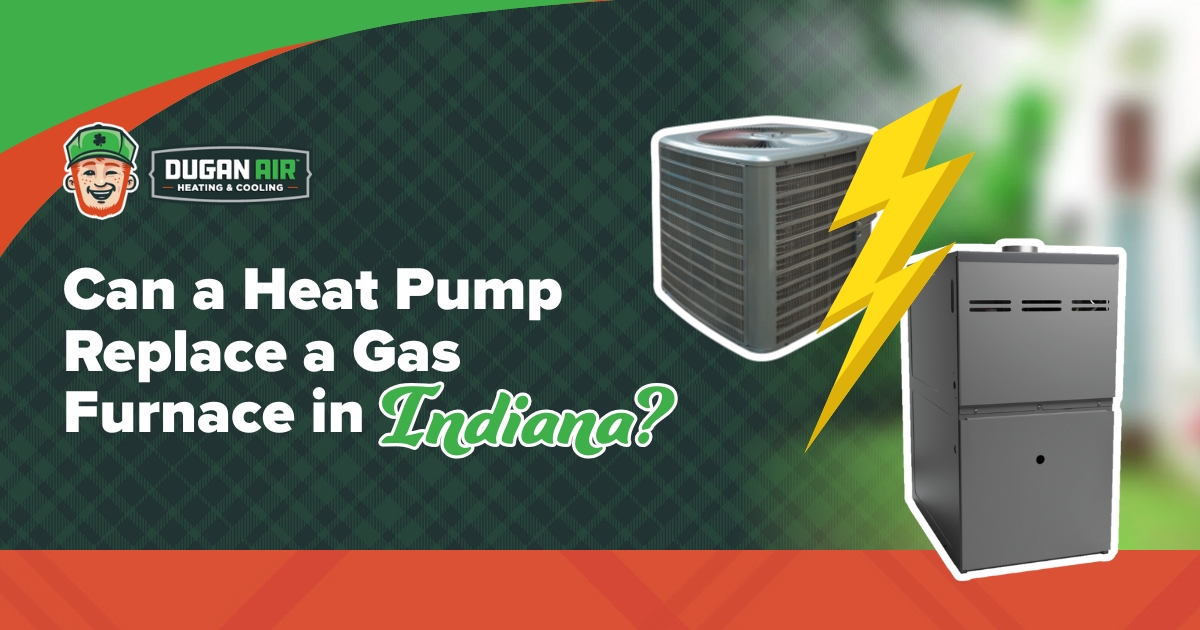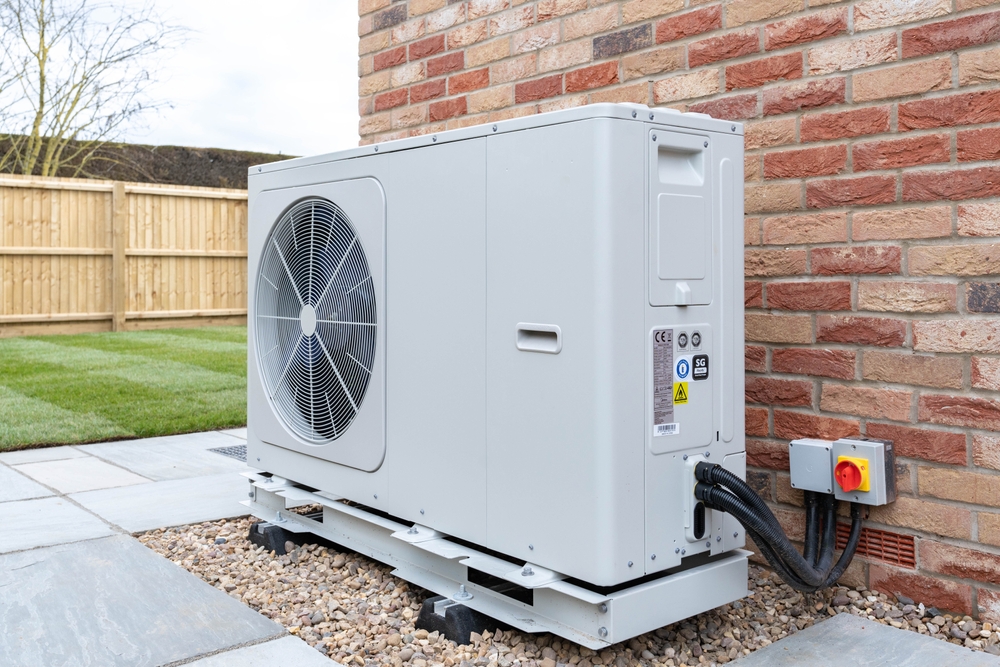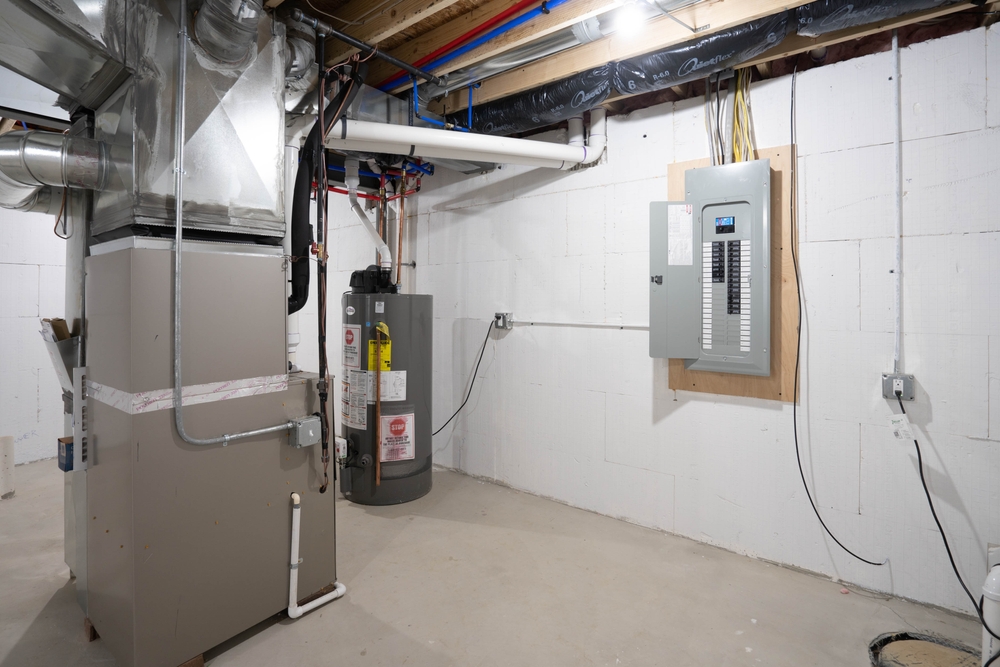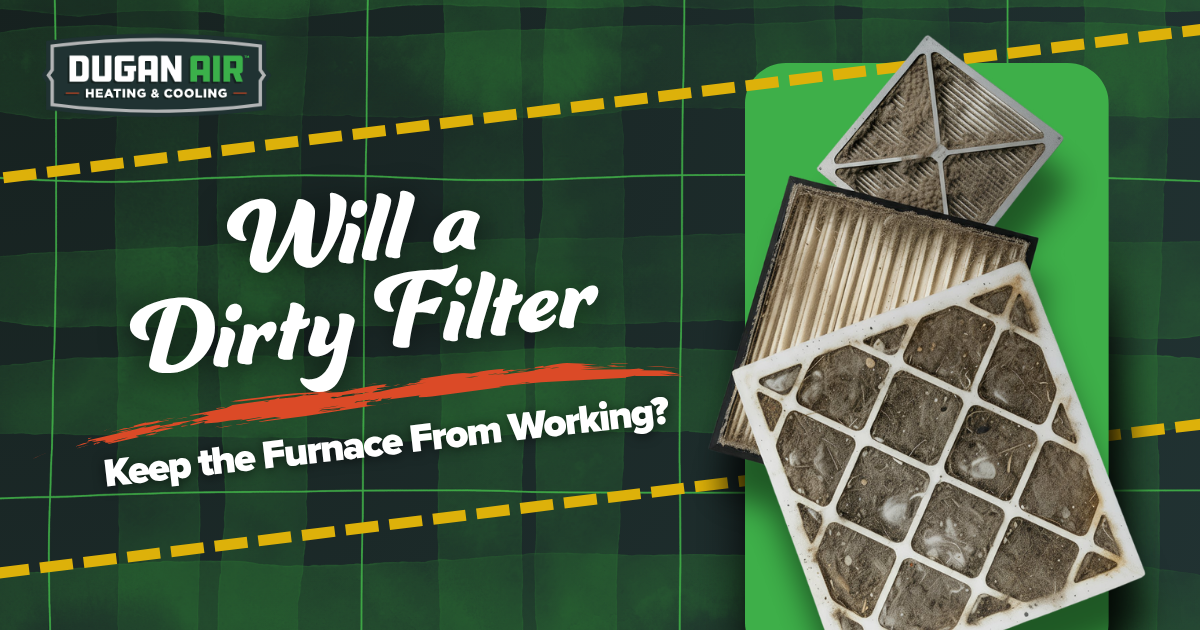Can a Heat Pump Replace a Gas Furnace in Indiana?

With increasing energy costs, updated efficiency standards, and rebates expiring at the end of 2025, a heat pump replacement is an appealing option for many Indiana homeowners. Heat pumps offer heating power and energy efficiency, with the potential to outperform gas furnaces, but the right choice depends on several factors. Learn more about how heat pumps work, how they compare to furnaces, and when to schedule an installation with Dugan Air.
What Is a Heat Pump and How Does It Work?

A heat pump is an HVAC system that provides heating and cooling in a single unit. While furnaces burn fuel to generate heat, heat pumps transfer heat between indoors and outdoors.
The system uses a refrigerant-based process to transfer heat, supported by evaporator coils, condenser coils, a compressor, and fans. Refrigerant circulates between the indoor and outdoor units in a closed loop. In winter, it extracts heat from outdoor air and moves it indoors. In summer, this process reverses, drawing heat from inside the home and expelling it outdoors.
Key Differences Between Heat Pumps and Furnaces
Heat pumps and furnaces heat your home to maintain comfort, but they do so in different ways. Understanding how these systems differ in installation, fuel sources, efficiency, and upkeep helps you select the ideal model for your heating system replacement.

Installation
Gas furnace installation requires connecting the system to a fuel line and setting up a ventilation system to safely release combustion gases. The furnace connects to ductwork, which distributes heated air throughout your home. Some homes have existing gas lines, but others may need to set up new service connections. Electric furnaces are less complex to install since they don’t require fuel lines or venting, but they may require setting up a dedicated electrical circuit.
Heat pumps involve installing both indoor and outdoor components. Indoors, you can configure a heat pump to connect to existing ductwork or to deliver heated air directly to a space. These units typically mount onto walls and ceilings. Outdoors, the condenser unit mounts onto a concrete pad or wall bracket and connects to the indoor unit with refrigerant lines. Heat pumps also generally require a dedicated electrical circuit.
Fuel source and operation
Furnaces generate heat by burning fuel, such as gas or oil, or by using electricity to power resistance heating coils. These systems are single-purpose and only provide heating.
Rather than heating the air directly, heat pumps use electricity to power the compressor and fans and transfer heat. Most systems feature reverse valves, which enable them to reverse the refrigerant process and switch between heating and cooling as needed.
Performance and energy efficiency
Gas furnaces deliver steady, powerful heat regardless of outdoor temperatures. They are especially reliable in freezing conditions or for heating large homes, and high-efficiency models can exceed annual fuel utilization efficiency (AFUE) ratings above 90%. Electric furnaces offer similarly high efficiency, but they can cost more to run since electric heating is less powerful and electricity rates are often higher than natural gas prices.
Heat pumps operate at high efficiency, especially in mild and moderate climates, and can deliver up to three times more heating energy compared to electricity consumption. While older heat pump models lost efficiency at below-freezing temperatures, modern units and cold-climate models allow these systems to perform efficiently even at temperatures below 5°F. This efficiency reduces operating costs and helps households transition to cleaner energy sources.
Can You Replace a Gas Furnace With a Heat Pump in Indiana?
It’s possible to replace a furnace with a heat pump in an Indiana home, but the right choice depends on several factors, such as climate and existing HVAC equipment. Consider performance, long-term energy savings, and upfront installation costs.
For instance, Indiana winters vary in severity, and some households are better suited to different heat pump, furnace, or dual-fuel configurations. Cold climate models can heat during below-freezing conditions, but consistently sub-5°F temperatures may make a gas furnace more cost-effective, especially for larger homes with bigger heating loads. Some homeowners opt to use a heat pump in conjunction with a furnace, where the heat pump handles heating for most of the time, and the furnace acts as backup during extreme conditions.
If your gas furnace’s existing ductwork is in good condition and properly designed for your home’s heating load, you can choose between a heat pump or a new furnace. If your ductwork is in poor condition or requires significant modifications, a ductless heat pump may offer a more straightforward and economical installation.
When a Heat Pump Alone Is Sufficient
Many homeowners find that a heat pump alone meets their heating and cooling needs, depending on their property and location. Consider these factors:
- Insulation: Homes with modern insulation and proper sealing retain heat more effectively. With less energy loss, heat pumps can maintain indoor comfort more efficiently when temperatures drop.
- Location: While the snow belt in Northern Indiana experiences the most severe winter conditions, homes in central and southern Indiana have fewer days of extreme cold and may be better matched to heat pumps.
- Environmental goals: For families aiming to reduce fossil fuel use and emissions, a heat pump may offer more efficient heating than an electric furnace.
Average Installation Costs for Heat Pumps
Heat pump replacement costs depend on the system configuration and size, ranging between $3,500 and $8,800, but heat pump efficiency and lower utility bills can offset upfront costs. Ductwork modifications and electrical upgrades may increase the cost of basic heat pump installations, and mini-split heat pump systems may have high upfront costs depending on the number of indoor units installed.
Available Rebates & Tax Credits for Heat Pump Replacements
Tax credits and rebates available to Indiana homeowners make upgrading to a heat pump more affordable. The Indiana Energy Saver Program offers two rebate programs for energy-efficient upgrades, including the Home Efficiency Rebate (HOMES) program and the Home Appliance Rebate (HEAR) program. AES Indiana also offers home improvement incentives with up to $725 in rebates for heat pump installation.
Federally, the Inflation Reduction Act provides a 30% tax credit, up to $2,000, for qualifying ENERGY STAR heat pumps. This program is only available until December 31, 2025, so start planning for a replacement with Dugan Air to maximize your savings.
Why Choose Dugan Air for Heat Pump Replacement in Indiana?

At Dugan Air, we bring expert installation and our Golden Service approach to customers in Greenwood, Bargersville, and other Indiana communities. Our customers enjoy these advantages:
- Premium service with clear communication and no shenanigans
- Locally owned and operated in Indiana
- 24/7 emergency service availability
- Flexible financing options to suit your budget
- Certified HVAC technicians with expert heat pump and furnace skills
- Comprehensive maintenance plans
Upgrade To a Heat Pump With Dugan Air
Replacing a gas furnace with a heat pump in Indiana offers improved comfort, efficiency, and long-term cost savings, but the right decision depends on your specific needs. With rebate programs expiring at the end of the year, let Dugan Air help you choose the best heat pump system for your home. Contact us today to schedule an installation and see how a heat pump can transform your home comfort.

HOW CAN WE HELP?
Request Service second home page


Join Our Premium Clover Club
Take Advantage of Our HVAC Maintenance Plan
Have you ever wondered if a service plan is really the pot of gold it’s rumored to be? Trust us — ours is! Signing up for a Premium Clover Club membership includes the following perks:
- Annual heating and cooling checks
- Discounts on repairs and parts
- Waived service call and overtime fees
- Priority scheduling
- Peace of mind
 Upgrade Today: $2,009 Buy-Back Credit for Your Old AC & Furnace! Financing Available!
Upgrade Today: $2,009 Buy-Back Credit for Your Old AC & Furnace! Financing Available!





